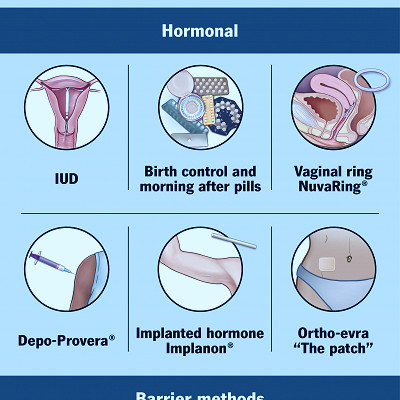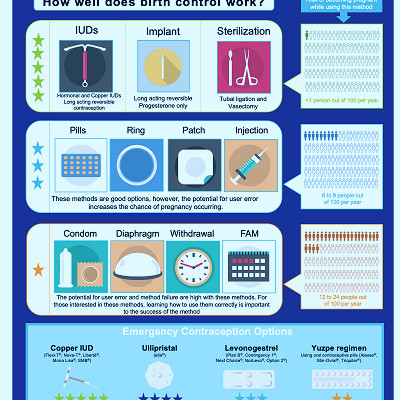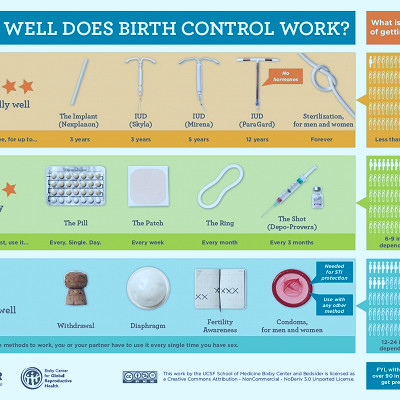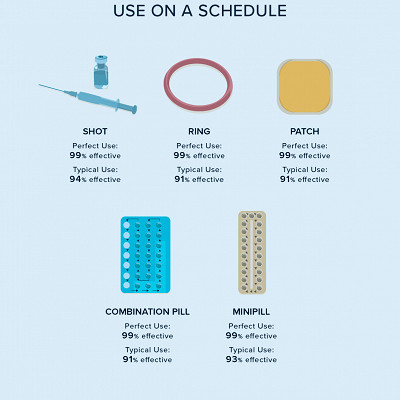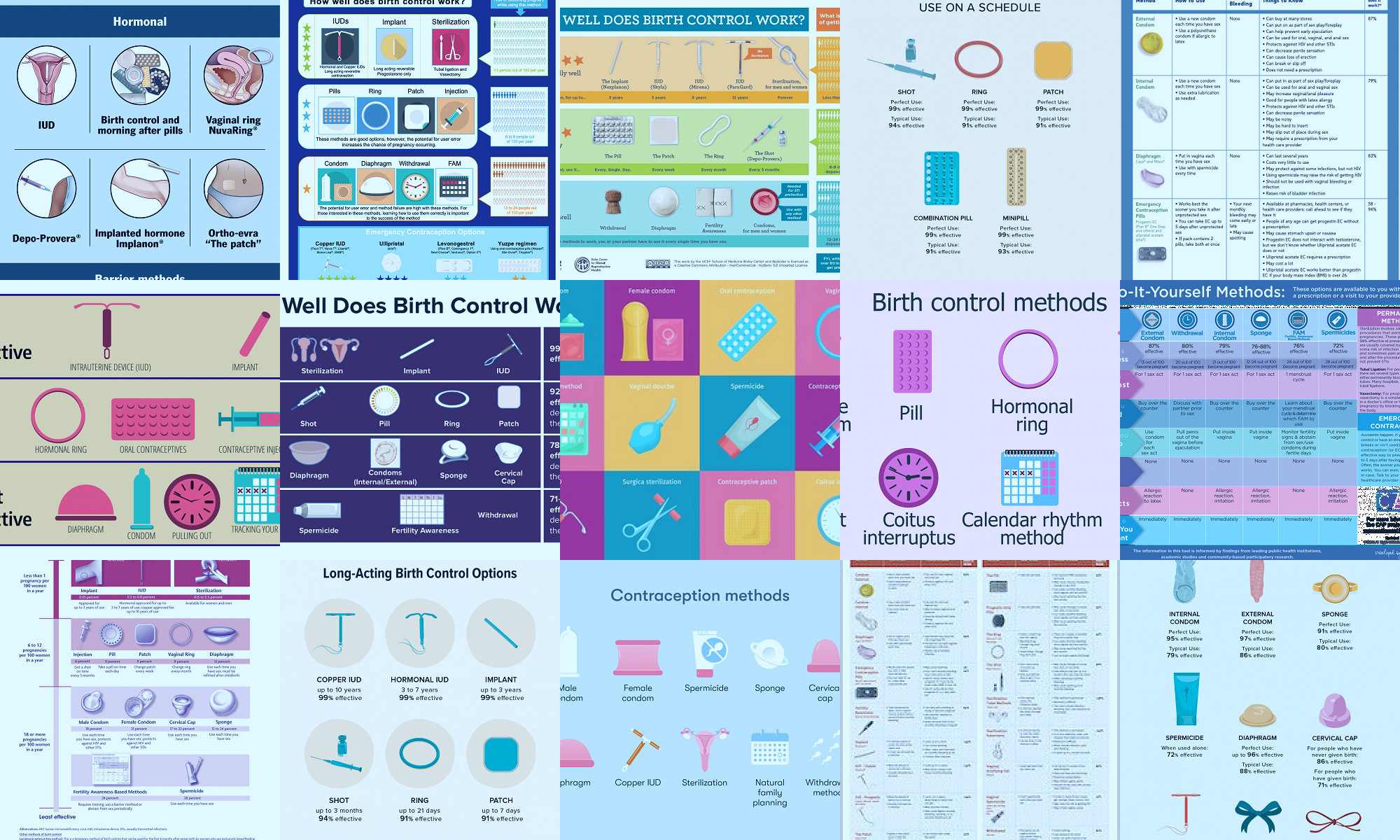 Jarlat Maletych/Shutterstock
Jarlat Maletych/Shutterstock
Features
Understanding Birth Control
Birth control, also known as contraception, is designed to prevent pregnancy. Different methods work in varying ways such as preventing sperm from getting to the eggs, ensuring eggs are not released, or thickening cervical mucus to block sperm.
Hormonal Contraceptive Methods
Hormonal contraceptives work by regulating a woman's fertility cycle to prevent ovulation. These include birth control pills, patches, vaginal rings, implants, and injections. They are highly effective when used correctly and consistently.
Barrier Methods of Contraception
Barrier methods, such as condoms, diaphragms, and cervical caps, physically prevent sperm from reaching the egg. They offer the additional benefit of protecting against sexually transmitted infections (STIs).
Intrauterine Devices (IUDs)
IUDs are small devices inserted into the uterus to prevent pregnancy. There are two types: copper IUDs, which release copper to stop the egg from fertilizing, and hormonal IUDs, which release progestin to thicken cervical mucus and thin the uterine lining.
Emergency Contraception
Emergency contraceptive pills (morning-after pills) are used within 72 hours of unprotected sex to prevent pregnancy. They primarily work by delaying ovulation.
Fertility Awareness-Based Methods
These methods involve tracking menstrual cycles to identify fertile days and abstaining from sex or using protection on those days. This requires a good understanding of one's body and careful tracking.
Sterilization
Surgical sterilization provides a permanent solution to birth control. In women, tubal ligation (tying the fallopian tubes) prevents eggs from reaching the uterus. In men, vasectomy (cutting the vas deferens) stops sperm from reaching the ejaculate.
Hormonal Contraceptive Side Effects
While highly effective, hormonal contraceptives may have side effects like mood changes, weight gain, and increased risk of blood clots in some individuals.
Natural Contraception
Natural methods such as withdrawal or "pull-out" method and lactational amenorrhea method (breastfeeding as birth control) can be used. However, they require careful practice and are less effective than other methods.
Condom Usage
Condoms, both male and female types, are the only method that offers protection against both pregnancy and STIs. Proper usage is crucial for effectiveness.
Long-Acting Reversible Contraception
Methods like IUDs and implants fall under this category. They provide birth control from three to ten years, depending on the type.
Menstrual Cycle and Fertility
Understanding the menstrual cycle is critical for fertility awareness-based methods. Ovulation typically occurs in the middle of the cycle, which is the most fertile period.
Birth Control Pills
Oral contraceptives are highly effective but must be taken consistently. They contain synthetic hormones that prevent ovulation.
Contraceptive Patch and Ring
These methods deliver hormones through the skin or vaginal lining. They require less frequent attention than pills but work on the same principle.
Birth Control Shot
The contraceptive injection, often known as Depo-Provera, provides protection for three months. It releases progestin to stop ovulation and thicken cervical mucus.
Contraceptive Implants and IUDs
These methods provide long-term birth control without requiring daily attention. They are highly effective and reversible.
Emergency Contraceptive Pills
Also known as "morning-after" pills, they should be used as soon as possible after unprotected sex. They are not intended for regular use.
Permanent Birth Control
Sterilization provides a permanent solution for those who are certain they do not want more children. It should be considered irreversible.
Side Effects and Risks
All methods have potential side effects and risks, and these should be discussed with a healthcare provider. The benefits usually outweigh the risks for most individuals.
Choosing the Right Method
The choice of birth control should consider personal health, lifestyle, comfort, and reproductive goals. A healthcare provider can provide guidance in making the best decision.
Interesting notes and facts
1. The Pill: One of the most common and popular methods of contraception, the birth control pill is a daily medication that contains hormones to prevent ovulation. It's up to 99% effective when used correctly. However, it's essential to take it at the same time every day to ensure maximum effectiveness.2. Intrauterine Devices (IUDs): An IUD is a small device that's inserted into the uterus to prevent pregnancy. There are two types of IUDs, hormonal and copper, both of which have a high success rate of over 99%. They're a long-term, reversible birth control method that can last for 3 to 10 years, depending on the type.
3. Condoms: Condoms are a barrier method of birth control that prevent sperm from reaching the egg. They're also the only method that can protect against sexually transmitted infections (STIs). They have an effectiveness rate of about 85%.
4. Birth Control Shot (Depo-Provera): This is an injection that prevents ovulation and thickens cervical mucus to keep sperm from reaching the egg. It's administered every three months and has an effectiveness rate of about 94%.
5. Implants: Birth control implants are a type of long-acting reversible contraception. The small, flexible rod is inserted under the skin of the upper arm and can prevent pregnancy for up to 3 years. It's over 99% effective.
6. Natural Family Planning: This method involves tracking menstrual cycles and abstaining from sex on the days when you're most fertile. It requires a good understanding of your body and menstrual cycle and has a variable effectiveness rate.
7. Emergency Contraception: Also known as the morning-after pill, it's used to prevent pregnancy after unprotected sex or contraceptive failure. It's most effective when taken as soon as possible after sex.
8. Vaginal Ring: A small, flexible ring that's inserted into the vagina once a month for three weeks at a time. It releases hormones to prevent ovulation and is about 91% effective.
9. Birth Control Patch: This is a patch that sticks to your skin to prevent pregnancy. It releases hormones through the skin into the bloodstream. It must be replaced weekly and is about 91% effective.
10. Sterilization: This is a permanent method of birth control that involves surgical procedures for men (vasectomy) or women (tubal ligation). It's nearly 100% effective, but it's also irreversible.
Vocabulary
- Acupuncture – A traditional form of Chinese medicine involving the insertion of thin needles into specific points on the body for therapeutic purposes.
- Aerobic Exercise – A form of physical activity that increases heart rate and breathing, helping to improve cardiovascular health.
- Antioxidants – Substances that help prevent or slow down cell damage caused by free radicals.
- Aromatherapy – A holistic healing treatment that uses natural plant extracts to promote health and well-being.
- Balanced Diet – A diet that includes a variety of different foods in the right proportions to maintain health and energy.
- Biofeedback – A technique you can use to learn to control some of your body's functions, such as heart rate.
- Body Mass Index (BMI) – A measurement calculated using weight and height to assess whether a person has a healthy body weight.
- Chiropractic – A form of alternative medicine that involves treatment of mechanical disorders of the musculoskeletal system, especially the spine.
- Detoxification – The process of removing toxic substances from the body.
- Dietary Supplements – Products taken orally that contain a dietary ingredient intended to supplement the diet.
- Fasting – The practice of abstaining from all or some kinds of food or drink for a certain period of time.
- Gluten-Free Diet – A diet that excludes the protein gluten, which is found in grains such as wheat, barley and rye.
- Herbal Medicine – The study of the use of medicinal plants.
- Holistic Health – An approach to life that considers the whole person and how they interact with their environment.
- Homeopathy – A system of alternative medicine based on the idea that the body can cure itself.
- Hydration – The process of providing an adequate amount of fluid to the body's cells.
- Immunization – The process by which a person's immune system becomes fortified against an agent.
- Integrative Medicine – A holistic approach to healthcare that combines conventional medicine with complementary and alternative therapies.
- Juicing – The process of extracting juice from fruits and vegetables.
- Ketogenic Diet – A high-fat, adequate-protein, low-carbohydrate diet that forces the body to burn fats rather than carbohydrates.
- Macrobiotic Diet – A diet that emphasizes whole grains, fruits and vegetables, and avoids refined foods and most animal products.
- Meditation – A practice where an individual uses a technique to achieve a mentally clear and emotionally calm state.
- Naturopathy – A form of alternative medicine that advocates a holistic approach to health and wellness.
- Nutraceuticals – Products derived from food sources with extra health benefits beyond the basic nutritional value found in foods.
- Organic Foods – Foods produced without the use of certain pesticides and fertilizers.
- Osteopathy – A type of alternative medicine that emphasizes physical manipulation of muscle tissue and bones.
- Paleolithic Diet – A diet based on the types of foods presumed to have been eaten by early humans.
- Physical Therapy – The treatment or management of physical disability, malfunction, or pain by exercise, massage, hydrotherapy, etc.
- Probiotics – Live bacteria and yeasts that are good for your health, especially your digestive system.
- Reiki – A form of alternative therapy commonly referred to as energy healing.
- Superfoods – A nutrient-rich food considered to be especially beneficial for health and well-being.
- Tai Chi – A Chinese martial art practiced for both its defense training, its health benefits and meditation.
- Veganism – The practice of abstaining from the use of animal products, particularly in diet.
- Vegetarianism – The practice of abstaining from the consumption of meat.
- Vitamins – Organic compounds that are essential in small quantities for normal physiological function.
- Weight Training – A type of strength training for developing the strength and size of skeletal muscles.
- Yoga – A Hindu spiritual and ascetic discipline which includes breath control, meditation, and flexible bodily postures.
- Zinc – A mineral that is important to the body in many ways, including immunity, cell growth and division, sleep, mood, and senses of taste and smell.
- Omega-3 Fatty Acids – A type of fat that is beneficial for heart health.
- Insulin – A hormone made by the pancreas that allows your body to use sugar from carbohydrates in the food that you eat for energy.
- Cardiovascular Exercise – Physical activity that raises your heart rate to improve your heart, lung and circulatory system health.
- Calorie – A unit of energy. In nutrition, calories refer to the energy people get from the food and drink they consume, and the energy they use in physical activity.
- Fiber – A type of carbohydrate that the body can’t digest. It helps regulate the body’s use of sugars, helping to keep hunger and blood sugar in check
